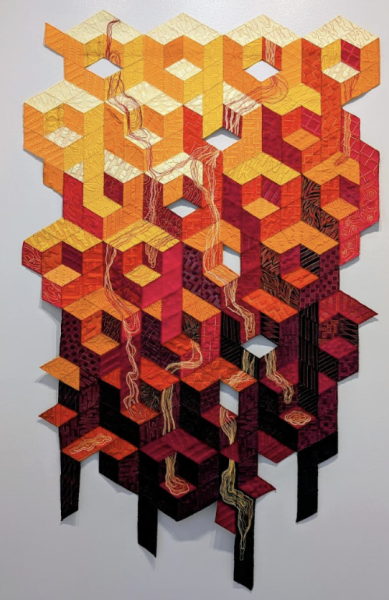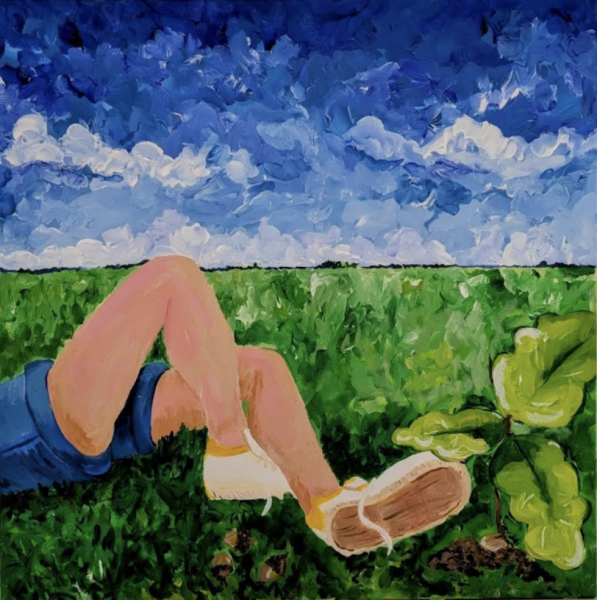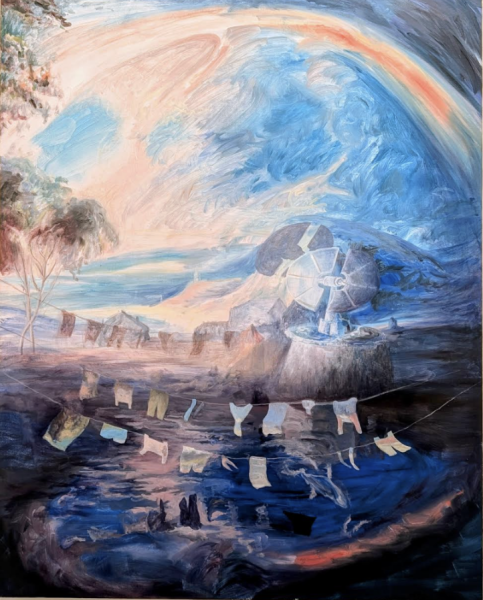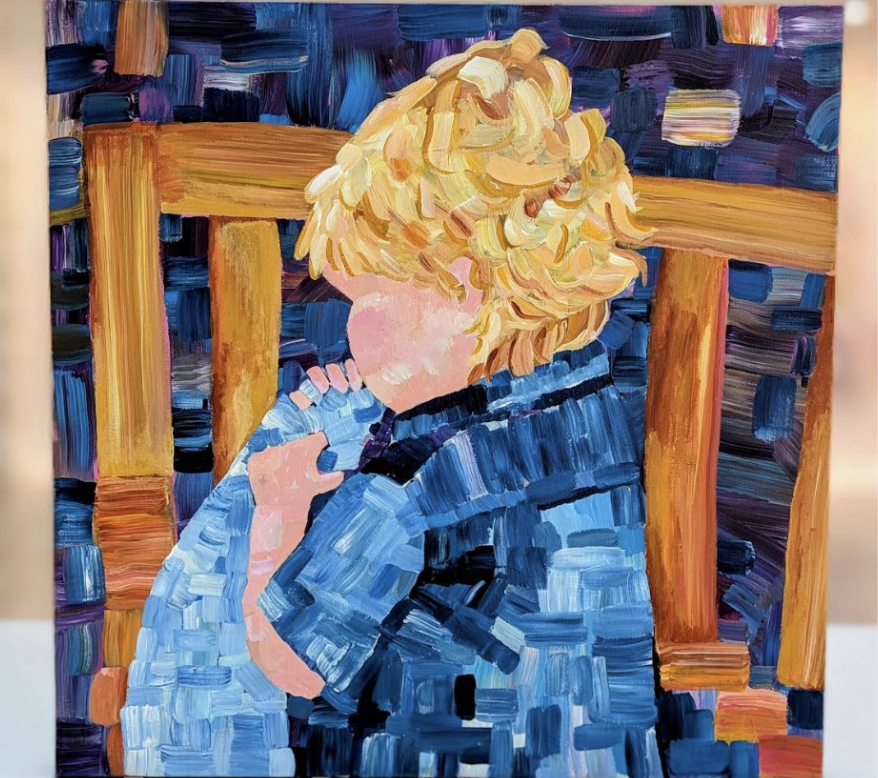Every year, Broyles Art Gallery hosts the annual Faculty Art Show, where Visual Arts teachers from the Lower School, Middle School, and Upper School are invited to showcase their work. The show provides an opportunity for faculty who, while supporting young people in their art, can inspire others by exhibiting pieces of their own.
Ms. Jones Spotlight:

Middle School art teacher Lauri Jones is exhibiting a large, colorful quilt in the show. According to Jones, this piece is different from the other quilts she has worked on. “For this particular piece, I was really excited about the idea of constraining myself to just one shape . . . it is entirely diamonds that are put together,” she says. “I love the idea of not being able to tell if it is three dimensional or not. I really like that it is a piece that can be viewed from far away, but when you come closer, there’s so much more to see because there’s so much tiny detail.”
Prior to her career in education, Ms. Jones spent fifteen years working professionally as a graphic designer, focusing on television and animation. “I feel like so much of my design background comes into my quilting,” she says. “So much of my sort of my love for geometry and grids and all that kind of stuff that is very much a part of graphic design, type, typography and letter forms. I explore it now in a different medium.”
Ms. Sather Spotlight:
 The show includes several works by Middle School art teacher Cybil Sather, who completed them during a master’s program over the summer. “Most of the pieces of mine . . . all have a common theme of waiting . . . waiting is not a negative thing . . . sometimes we become impatient and we sit and ponder and we fester,” she says. “But in the grand scheme of things, it’s there for a reason and that there are very positive things that can come out of waiting.”
The show includes several works by Middle School art teacher Cybil Sather, who completed them during a master’s program over the summer. “Most of the pieces of mine . . . all have a common theme of waiting . . . waiting is not a negative thing . . . sometimes we become impatient and we sit and ponder and we fester,” she says. “But in the grand scheme of things, it’s there for a reason and that there are very positive things that can come out of waiting.”
Sather loves the impact that art has on young people. “My two passions are art and life sciences, and I thought I wanted to be a science teacher, which I still love the idea of, but art kind of took hold . . . visual arts are still new to some students . . . who haven’t had the opportunity to work with clay or paint a mural . . . it’s really cool to see those hidden talents that they weren’t exposed to.”
Mr. Steele Spotlight:
 The teacher in charge of the show, Visual Arts Chair Ben Steele, mixes art with creations from history and history-to-be. “So I have developed a process where all of my paintings are based on models originally, so it’s, like, actual forms that I’m building,” he says. “These forms all kind of are inspired by futuristic architecture and inventions and science fiction. The works that you see here, I’m also taking them through a whole process where I project old master landscape paintings onto them.”
The teacher in charge of the show, Visual Arts Chair Ben Steele, mixes art with creations from history and history-to-be. “So I have developed a process where all of my paintings are based on models originally, so it’s, like, actual forms that I’m building,” he says. “These forms all kind of are inspired by futuristic architecture and inventions and science fiction. The works that you see here, I’m also taking them through a whole process where I project old master landscape paintings onto them.”
For his piece Receiving Airwaves, Steele uses objects that only feel like they should be from different periods in time. “So, for example, you have this piece where you have a clothesline and a satellite dish . . . and I was just thinking about very different uses of . . . invention and technology and awareness across history too, because the work is a lot about time. I like to put things kind-of juxtaposed together that feel like they’re from different time zones. ”
Advice for Young Artists:
Because Jones’ love for quilting is fairly recent, she advises students to have open minds when it comes to art mediums. “I’ve been making art my whole entire life, but I only started quilting about 10 years ago. You just never know what you’re going to stumble upon and fall in love with, so stay open. Even if you think that you have found your thing, try different things because you can always learn more.”
Sather agrees. “The art teachers seem to agree that art is very subjective, and there is so much more that you can do with it than you think. I would say experiment and try [to] keep exploring with new materials. That’s the hard part, but that’s also the exciting part.”
Steele teaches his students about the importance of failing before you succeed. “What I tell students is usually, if they apply for something and they don’t get it, it’s almost like it feels like the world is over,” he says. “What I try to tell them is, when you get out in the world, anything that’s worth doing, you’re gonna fail a lot before you get anything. So it’s my rule of thumb that if I put out 20 applications and I get one thing back from that, that’s a good ratio. So kind of have that in your head that seeking and going for the things that you want to do is just a process. And if you just keep doing it, then things will come back to you eventually.”
Westminster’s Influence on Art:
The art show also models how members of the faculty are influenced by the work of their colleagues. “You’re inspired by other faculty members that you might not know on a personal level . . . but then to see . . . their creative side on top of what they do in the classroom is very influential and inspiring,” Sather says.
Steele feels similarly. “Every year we’ve kind of devoted larger parts of the show to certain people . . . and I think it’s always really valuable to see what someone can do when given a platform like that.” Steele also values the community the faculty get out of the Art Show. “This is kind of like a rare point of contact where you have really people across the entire campus coming together: community members . . . there aren’t many events even within a department where you see all three divisions together.”
Jones agrees. “The art teachers here are all so talented, and I’m inspired by them.” However, Jones also finds inspiration in her students. “I just think that young people are so creative and open-minded, and it really allows me to look at things in new ways.”


